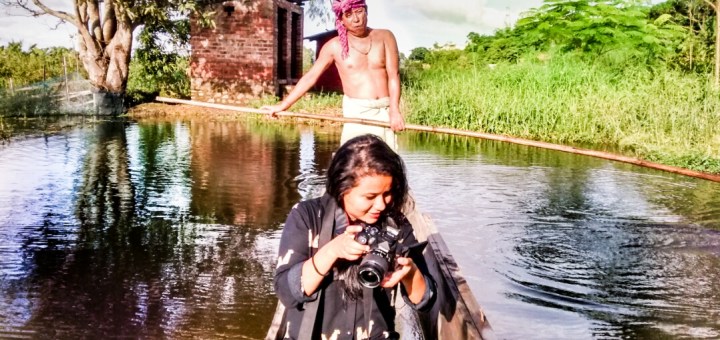Loktak Lake brings back some of the fondest travel memories. I find myself time and again going back to staring the vast expanse of the lakes with scattered floating biomass called Phumdis, dotted with fishermen huts. I stayed two nights adjacent to a fishermen family in a cosy homestay on Loktak Lake. It was indeed the warmest and one of the most memorable travel experiences, close to my heart and lifts my soul.
Wrapped in my cosy Naga shawl, I stepped outside the homestay on the bamboo planks skillfully tied together into a narrow makeshift verandah. There was a nip in the air. I pulled the shawl into a tight embrace as I stared at the glassy water of Loktak Lake, reflecting the palette of colours peeping through the cottony clouds. The hills overlooked the lake, and the fishermen bustled through the lake on their boats for their morning catch. As I sat sipping warm lemongrass tea, a boat rowed past the homestay and disappeared behind a hut perched on a floating decomposed biomass on water.
Also read: India’s First Ever Floating School Is Meant For Illiterate Adults & Drop Out Students

Unique Ecosystem Of Loktak Lake
Loktak Lake is one of the largest freshwater lakes of North East India located in Moirang, Manipur. It is popularly known for decomposed floating biomass (plants steeped with soil and water) spread unevenly across the lake. These floating biomasses are called Phumdis. The local fishermen live on these Phumdis by building huts called as Phumsang. Fishermen huts and fishing coves float along the lake, although a part of the lake falls under conservation area which is relatively clear of the Phumdis and fishers habitats. The thick growth of water plant across the lake makes it difficult at times to paddle through the boats.
Life On Floating Lake For The Fishermen Community
The local fishermen live on the lake dangling to the floating biomass in their makeshift huts on the Phumdis. A canoe ride across the boat will give a closer glimpse of the lives of the fishermen who lives on these soggy Phumdis. The paths are laid for walking on the Phumdis by laying wooden planks. The humble huts are made from bamboo and roofed with plastic tents. The fishermen live in borderline dilapidated condition on the Phumdis to earn their livelihood from the freshwater lake. Did You Know That World’s Only Floating National Park Is In Manipur?

Fishing – An Occupational Livelihood
The mornings on Loktak Lake starts with the fishermen getting ready with their fishing nets and bamboo baskets to catch their fishes. Fishing and selling their catch in the market is the only livelihood for these local fishermen. In the high season from June to August, the fishermen go on rampant fishing along the lake. The harmonious community of fishermen stands as an exemplary representation of unity. The community work together and help each other throughout. However, overfishing has been repulsive to the ecosystem and threatens the community around.
Local Produce From The Lake
Fishing provides herd livelihood to the local fishermen, but the lake is a vital source of many edible plant products. The plant products from the lake are used for cooking and preparing local delicacies. Food products like water chestnuts and lotus stem are commonly produced from the lake. The locals source their food edibles from the lake and sell it in the market. The prickly water lily is a consumable product where seeds are consumed as vegetables. These food products are collected and used for making ethnic food. These 7 Stunning Lakes Of Sikkim Are Sure To Leave You Spellbound.
Building Homes On The Phumdis
The huts perched on the Phumdis are dotted across the lake. The panoramic view of the lake can be glanced upon from atop a hill. The floating biomass spreads across the lake as far as eyes can see. The huts are built on fragments of Phumdis isolated from one another. The construction of houses on the Phumdis is a work of raw engineering. The base of the Phumdi is first strengthened by pushing more floating biomass underneath to stabilise it. After building the hut, wooden planks are laid out to walk on the wet biomass. Fresh Phumdis are cut from time to time and placed on the existing one to make it thick and strong. Surviving on these rickety huts afloat the lake is a meticulous job adopted by the fishermen.
Loktak Lake – A Giant Puddle Of Floating Mass
The view of the lake from the viewpoint is unique and different. From the vantage point, the lake opens up to the eyes like a giant puddle of floating mass, and green decomposed plant matter scattered all across. What stands out from the top is the view of the circular Phumdis perfectly spread across the lake. These are called Athaphum. The circular Phumdis are collectively made by the fishermen and used as fishing coves. After 3 to 4 months the fishes within the coves are caught, and host family organise a meal for the fellow fishermen to celebrate and show gratitude. This event is called Phumnamba. These 10 Most Unique Places In India Which Will Amaze You.
How To Travel And Explore Loktak Lake Responsibly
As a traveller, it is to our discretion of how responsible we want to be. Tourism stitches the gap of unemployment on the one hand but being irresponsible can hurt the ecosystem. There is tourist motorboat, but it has led to increasing pollution. The tourists harm the well being of the lake even by throwing off waste and plastic in the lake. So, visiting a place like Loktak Lake first requires you to commit to respecting the local culture and ecosystem.
Here are some ways to travel responsibly:
- Choose to stay in a homestay on Loktak Lake over bigger hotel chains or resorts. Loktak Aquamarine Homestay by Sangai Moonlight Camping is the best option to lodge on Loktak Lake on a Phumdi adjacent to a fishermen family.
- Go for a boat ride organised by the fishermen family on the wooden boat instead of the motorboats. This will give you a deeper glance of the lake.
- Limit using plastic and try the local cuisine to try the fresh plants, vegetables, and fishes from the lake.
- Talk to the locals and get to know the culture. People on the Lake are friendly and happy to share. However, be ready for a communication gap, though.
Contributed By
Upasana Kakati – A travel content creator and blogger, currently trying to know the cultural nuances and diversity of North East India. Read her travel stories here.
First Published: October 06, 2020 5:12 PM









